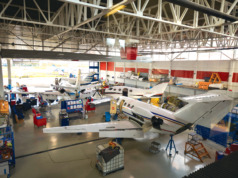
Whether you are a first-time buyer, or are upgrading to a different aircraft, you’ll want your aircraft to have a thorough pre-purchase inspection at a maintenance facility qualified to serve the specific make/model of aircraft you’ve selected (See “Inside View,” BAA July/August 2017).
There are different levels of pre-purchase inspection, depending on how deep you want to dig to reduce your risk. The history and condition of the aircraft ultimately determine your post-purchase ownership experience, so it’s important to get it right.
What Can You Expect?
The purchase process typically is cordial, that is, until the pre-buy inspection is mentioned. If you request a detailed inspection, it is normal to expect some pushback from the seller. However, an aircraft that is well maintained, operated regularly, and stored properly should not present any huge, surprising issues.
Assuming you already have a broker, step two in the process is to engage a qualified technical representative to be present during the entire pre-buy inspection. If you’re not a first-time buyer, your own mechanic can be your technical representative.
If you do not have a mechanic, where will you find this help? Shop around and get recommendations from credible sources. This person should report to and be contracted directly with you. Share your expectations as you begin, and agree on the communication process. Since his or her job is to protect you, this individual should have a well-seasoned maintenance background and experience on the exact model you are considering for purchase.
He or she has the responsibility of drafting a pre-purchase inspection checklist of critical items. Although Original Equipment Manufacturers (OEMs) do not provide a standard list, some maintenance facilities do. Together with the broker, your tech rep will negotiate a reasonable checklist of points to examine that is satisfactory to both you and the seller. The goal is not to “nitpick,” but instead to ensure certain areas are inspected, to avoid incurable or expensive problems.
While it is not necessary, or usual, to completely disassemble the entire aircraft, detailed records research on the engines, auxiliary power unit, and airframe is highly recommended to understand the aircraft’s history. Damage is not always obvious. However, a capable, experienced tech rep will know what to look for and what to ask. For example, a structure part change might trigger the question as to why this part was changed.
Step three is to have your pilot test the aircraft prior to the start of the inspection and again afterwards, at the acceptance flight. If this is your first aircraft purchase, you’ll need to hire an experienced contract pilot to perform these test flights on your behalf. Flying with the seller’s pilot, your pilot will verify that all systems work correctly. Your pilot should coordinate with your tech rep to confirm the specific items that need to be checked. Flying up to a normal cruise altitude will allow the pilot to perform appropriate operational checks. Doing so should identify most operational issues not detectable on the ground.
Obvious problems with avionics, autopilot systems, pressurization, cabin temperature, cabin noise, and flight characteristics will be revealed during this process. The pilot and tech rep then will debrief with you and the broker. They may add to the pre-purchase checklist items requiring further investigation and correction.
Sometimes, the seller may pressure you to close the deal quickly. Indecision or price negotiation could drag out for weeks.
To find a team of advisors with expertise and integrity, consider using those belonging to and recommended by aviation trade associations. They must adhere to a professional code of ethics and conduct. You need to be able to trust them to guide your decision process and know when it is right to move forward – or not – through the pre-purchase inspection. BAA
George Kleros, Senior VP, Advisory Services for Jet Support Services, Inc. (JSSI), has more than 30 years of experience in Aviation Maintenance, Management, and Field Support Services for business jet aircraft.





